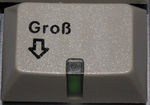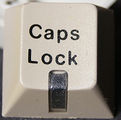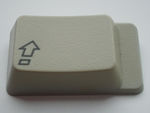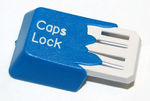Caps lock
Caps lock is a lock key found on most keyboards. Its purpose is to allow easy entry of capitalised letters; even in countries such as Japan where letter case does not exist, it is present for when the keyboard is used for text entry in European languages, primarily English. (The majority of the world's written systems do not in fact have a concept of case, but most countries keyboards feature Latin alphabet legends on the keys.)
Unlike the shift lock key, which locks shift down as with a typewriter, caps lock only affects the letter keys. With caps lock engaged, some systems, especially Microsoft Windows, support lowercase entry by holding shift to reverse caps lock; OS X does not support this behaviour. Acorn MOS on the Acorn BBC Microcomputer supports this behaviour when caps lock mode is engaged by pressing shift+caps lock.
Contents
Caps lock placement
Caps lock is a widely hated key.[1] It usually occupies a prominent place between Tab, Shift and A, and is easily engaged by mistake when reaching for A. To avoid this mistake, many keyboards have a stepped caps lock keycap that places a gap between caps lock and the adjacent letter key.
The key's placement is controversial. It is argued that the control key is much easier to use when placed where caps lock is normally situated. There are adapter kits to swap the caps lock and control keys on existing keyboards, as they typically have different shapes and sizes.
Disabling/reassigning
Most operating systems include methods to disable the caps lock key. (For example, in Microsoft Windows, this can be done by editing the system registry.)
Key-remapping software can also be used to disable caps lock, or to assign other characters or functions to it. One popular practice is to remap caps lock to a Windows (a.k.a. "Super") key on pre-1995 keyboards that lack the physical key.
Alternative placement keyboards
The following keyboards permit the control key to be moved to where caps lock normally is, or ship with control already in this position. They are all PC-compatible keyboards (AT, PS/2 and USB). The lists are not exhaustive.
Reversed as standard
Keyboards where caps lock and control are reversed as standard (see Unix layout):
Reversible
Many keyboards permit caps lock and control to be swapped by the owner. In most cases, this is done via DIP switch configuration; frequently, replacement keycaps are supplied as standard.
- Datadesk Switchboard/DSI Modular Pro
- Filco Minila (replacement keycaps supplied)
- Leopold FC660C (replacement keycaps supplied)
- Leopold FC660M
- Maxi Switch 218603 series
- Noppoo Choc Mini (change made in software via Switch Lock key)
- Topre Realforce 87U (replacement keycaps supplied)
Other
- IBM Model F AT: caps lock is relocated to the bottom-right of the main cluster
- Happy Hacking Keyboard series: caps lock is moved to fn+tab (HHKB Pro JP can be reverted to conventional arrangement via DIP switch SW2)
- WASD V2 and WASD CODE: caps lock can be converted to a third control key via DIP switch SW3; no control key changes to caps lock, which disappears from the keyboard
Design
There are multiple legends for the caps lock key. English keyboards normally use "Caps Lock". German keyboards are more likely to depict a downwards arrow ⇩, but a padlock symbol was also widely used; the padlock symbol is often referred to as a handbag (US: purse) due to its peculiar shape. European symbolic Apple keyboards typically show a normal shift arrow with a square below it: ⇪.
ISO/IEC 9995-7 mandates the symbol ⇬ but it is very unusual.
Separate Caps Lock lights often have the same legend as the key but also common is a padlock symbol with the capital letter 'A' inside.
Cherry G80-2510 shows a stylized lock.
Cherry G80-2550 shows a stylized lock. Variant with step and blue down arrow.
Olivetti KBD 2812 (Cherry G81-3011) shows a stylized lock.
Cherry G80-1000 with step and the usual down arrow.
Cherry G80-0778 labeled Groß (big)
Cherry G80-9013 with indicator LED and the usual down arrow.
Cherry G80-1501 with LED and down arrow (light grey version).
Cherry V80-5000 shows a stylized lock.
Clear caps lock key from Signature Plastics on a G80-9013.
Cherry G80-1501HAD (White Variant)
Cherry G80-3000HAU (White Variant)
Cherry G80-9xxx Alcatel OEM Phoneboard
Cherry G80-0801 (Nixdorf OEM)
A triple-shot variant, made by Access IS.
Dolch PAC OEM caps lock, Cherry G80-1813HFX
Nixdorf Softclick, OEM by Cherry
Symbolic caps lock from a European AppleDesign Keyboard for Macintosh
Half-finished cap from Signature Plastics
Alps lock switch in closed state in an Apple M0116
References
- ↑ CAPSoff — History of the War against Caps Lock
























